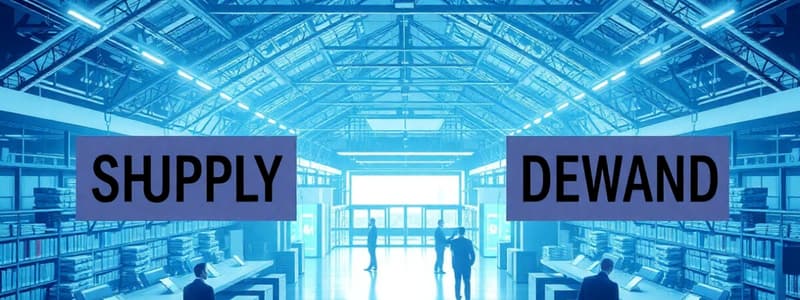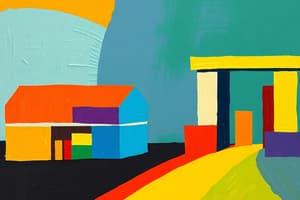Podcast
Questions and Answers
What is the primary problem that scarcity creates in an economy?
What is the primary problem that scarcity creates in an economy?
- Choices must be made regarding resource allocation. (correct)
- Government regulation is mandated.
- Unlimited resources are available.
- Economic indicators become irrelevant.
In a perfectly competitive market, which of the following characteristics is NOT true?
In a perfectly competitive market, which of the following characteristics is NOT true?
- High barriers to entry exist.
- Products are homogeneous.
- Many sellers are present.
- Easy entry and exit are possible. (correct)
Which factor of production refers to the tools and equipment used in production?
Which factor of production refers to the tools and equipment used in production?
- Entrepreneurship
- Capital (correct)
- Land
- Labor
Which economic system relies on a central authority to make economic decisions?
Which economic system relies on a central authority to make economic decisions?
What does the unemployment rate measure?
What does the unemployment rate measure?
Which concept describes a country’s ability to produce goods at lower opportunity costs?
Which concept describes a country’s ability to produce goods at lower opportunity costs?
Which of the following is an example of fiscal policy?
Which of the following is an example of fiscal policy?
What is the outcome of economic growth?
What is the outcome of economic growth?
Flashcards are hidden until you start studying
Study Notes
Elements of Economy
-
Scarcity
- Fundamental economic problem: limited resources vs. unlimited wants.
- Forces choices and prioritization of resource allocation.
-
Supply and Demand
- Supply: Quantity of goods/services producers are willing to sell at different prices.
- Demand: Quantity consumers are willing to purchase at different prices.
- Equilibrium: Point where supply equals demand.
-
Market Structures
- Perfect Competition: Many sellers, homogeneous products, easy entry/exit.
- Monopoly: Single seller, unique product, high barriers to entry.
- Oligopoly: Few sellers, either homogeneous or differentiated products.
- Monopolistic Competition: Many sellers, differentiated products.
-
Factors of Production
- Land: Natural resources used in production.
- Labor: Human effort and skills in production.
- Capital: Tools, equipment, and buildings used for production.
- Entrepreneurship: Innovation and risk-taking to combine other factors.
-
Economic Systems
- Traditional Economy: Based on customs and traditions.
- Command Economy: Central authority makes economic decisions.
- Market Economy: Decisions made by individuals based on supply/demand.
- Mixed Economy: Combination of market and command elements.
-
Economic Indicators
- Gross Domestic Product (GDP): Total value of goods/services produced.
- Unemployment Rate: Percentage of labor force that is unemployed.
- Inflation Rate: Rate at which general price levels rise.
-
Government's Role
- Regulation: Ensures fair competition and consumer protection.
- Fiscal Policy: Government spending and taxation to influence the economy.
- Monetary Policy: Control of the money supply and interest rates by the central bank.
-
International Trade
- Comparative Advantage: Ability of a country to produce goods at lower opportunity costs.
- Trade Barriers: Tariffs, quotas, and regulations affecting international trade.
- Globalization: Increased interconnectedness of economies worldwide.
-
Consumption and Investment
- Consumption: Use of goods/services by households.
- Investment: Spending on capital goods for future production.
-
Economic Growth
- Increase in output of goods/services over time.
- Influenced by factors like technological advancement, capital accumulation, and labor force growth.
These elements collectively shape the functioning and performance of an economy, influencing individual and collective economic behavior.
Scarcity
- Scarcity is the fundamental problem in economics, highlighting the contrast between limited resources and unlimited human wants.
- It necessitates choices and prioritization in how resources are allocated within an economy.
Supply and Demand
- Supply refers to the total amount of a good or service that producers are willing to sell at various prices.
- Demand represents the quantity of a product that consumers are prepared to purchase at different prices.
- Equilibrium occurs when the amount of supply matches the amount of demand, stabilizing market prices.
Market Structures
- Perfect Competition features many sellers offering identical products, with low barriers to entry.
- Monopoly is characterized by a single seller controlling the market for a unique product, resulting in high entry barriers.
- Oligopoly consists of a few sellers, which can offer either similar or varying products.
- Monopolistic Competition involves many sellers providing differentiated products, giving some control over prices.
Factors of Production
- Land encompasses natural resources that contribute to production processes.
- Labor includes the human effort and expertise involved in producing goods and services.
- Capital consists of physical assets like tools, machinery, and buildings necessary for production.
- Entrepreneurship involves the innovation and risk-taking needed to combine other factors for generating economic value.
Economic Systems
- Traditional Economy relies on customs and cultural practices to dictate production and distribution.
- Command Economy centrally manages the economy through authoritative decision-making.
- Market Economy enables individual decision-making based on supply and demand dynamics.
- Mixed Economy fuses elements from both market and command economies, balancing government influence with market freedom.
Economic Indicators
- Gross Domestic Product (GDP) reflects the total market value of all goods and services produced within a country over a specific time frame.
- Unemployment Rate quantifies the portion of the labor force that is jobless and actively seeking employment.
- Inflation Rate measures the pace at which the general price levels of goods and services are rising over time.
Government's Role
- Regulation promotes fair competition and protects consumers from exploitative practices.
- Fiscal Policy involves government strategies on spending and taxation to stimulate or contract economic activity.
- Monetary Policy pertains to the management of the money supply and interest rates by the central banking system to influence economic performance.
International Trade
- Comparative Advantage describes a country’s ability to produce goods at a lower opportunity cost compared to others, enhancing trade efficiency.
- Trade Barriers include tariffs, quotas, and regulations that hinder or regulate international trade flows.
- Globalization signifies the growing interconnectedness and interdependence of economies across the globe.
Consumption and Investment
- Consumption represents how households utilize goods and services to meet their needs.
- Investment involves allocating resources towards capital goods aimed at enhancing future production capabilities.
Economic Growth
- Economic growth is characterized by an increase in the output of goods and services over time.
- Growth is driven by factors such as advancements in technology, accumulation of capital, and expansion of the labor force.
Studying That Suits You
Use AI to generate personalized quizzes and flashcards to suit your learning preferences.




